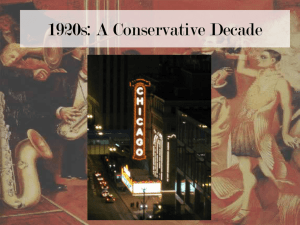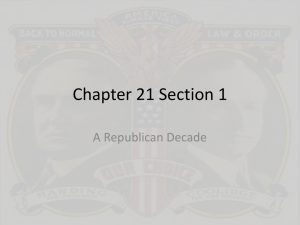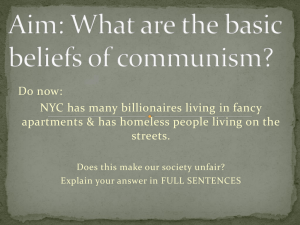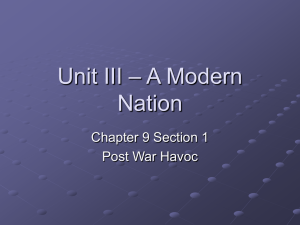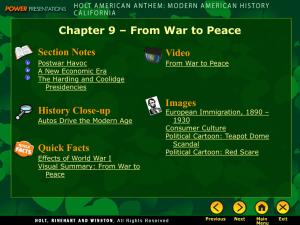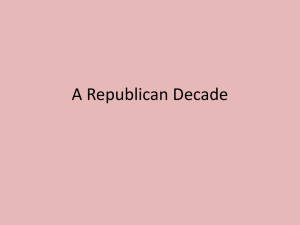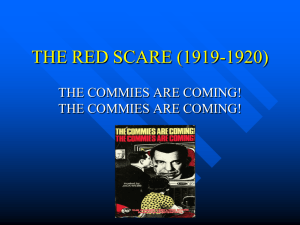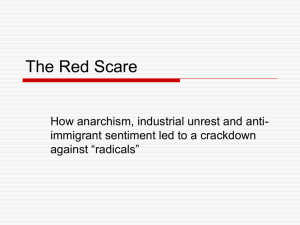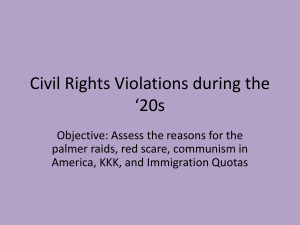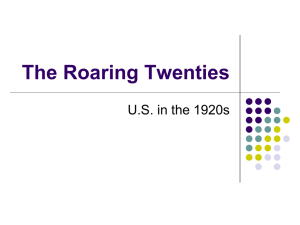Red Scare in America, 1919
advertisement
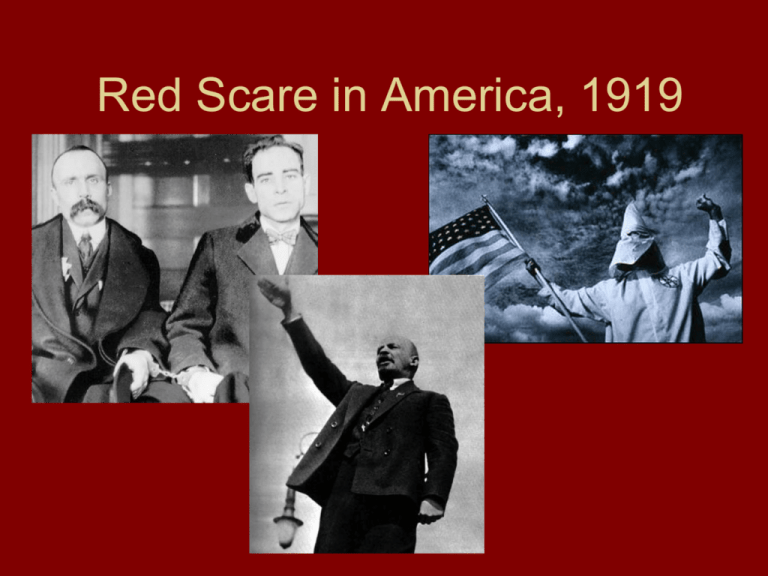
Red Scare in America, 1919 Problems of the 1920s, pg. 18 Russian Revolution KKK Rises Again! Sacco & Vanzetti Union Strikes The Red Scare Rise of the Bolsheviks American Reaction • Americans worried about a new enemy. • Many Americans were frightened by communism. • The Bolsheviks, a revolutionary group led by Vladimir I. Lenin, gained control of Russia during World War I. • Americans embraced capitalism and feared a rise of the working class. • Five years later Russia became part of a new nation called the Soviet Union. • The picture of “the Hun,” a German symbol, Americans focused hatred on during WWI, was replaced by a new target: communists, known as Reds. • The Bolsheviks wanted communism, a new social system without economic classes or private property. • Lenin believed all people should share equally in society’s wealth. • Soviets called for the overthrow of capitalism and predicted communism would inspire workers to rise up and crush it. • Communist parties formed in the U.S. after the war, some advocating violent overthrow of the government. • A Red Scare, or widespread fear of communism, gripped the nation. Russian Revolution • Food riots caused many soldiers to mutiny, desert, and caused the Czar to abdicate. • Bolshevik (Communist) Revolution started in Russia on Nov. 1917. • Communist government was established in Russia. • Communism: an economic and social system that advocated for single party and state ownership of property. ‘Sickle and Hammer’ became symbols of communism and the tools of the proletariat--working class. Economic Systems and Cows Pure Communism You have two cows. Your neighbors help you take care of them, and you all share the milk. Real World Communism You share two cows with your neighbors. No one works, no one gets any milk, and the cows drop dead of starvation. Russian Communism You have two cows. You have to take care of them, but the government takes all the milk. You steal back as much milk as you can and sell it on the black market. Cuban Communism You no longer have any cows. They sailed to Miami. You still have no milk - but you do have Fidel. Capitalism You have two cows. You sell one and buy a bull and build a herd. KKK Rises Again! • As a result of the Red Scare and rise of immigration, KKK came to rise. • KKK devoted to 100% Americanism: White,non-immigrant, Protestant, etc. • By 1924, it boasted over 4.5 million White male members. • Membership included states from Arkansas, California, Indiana, Ohio, Oklahoma, Oregon & Texas. In 1925, nearly 25,000 KKK members marched along Pennsylvania Ave. in Wash. D.C. to show the group’s power & determination. The rise of the KKK was a direct result of nativist views in the US: overt favoritism to native-born Americans. Sacco & Vanzetti • Red Scare raised suspicion of foreigners. • Nicola Sacco & Bartolomeo Vanzetti are Italian immigrants who are accused killing a paymaster and his guard for their $15,000 payroll. • The evidence against Sacco & Vanzetti was circumstantial & the judge made prejudicial remarks. • Jury found them guilty and sentenced them to death. Sacco & Vanzetti were judged for being anarchists—people who opposed any and all forms of govt– and for avoiding the draft during WWI. Worldwide demonstrations were held in the US, Europe and Latin America in protest of their executions. Last statement made by Vanzetti before he was executed by the electric chair on Aug. 23, 1927… “In all my life I have never stole, never killed, never spilled blood…We were tried during a time…when there was hysteria of resentment and hate against the people of our principles, against the foreigner…I am suffering because I am a radical and indded I am a radical; I have suffered because I was an Italian and indeed I am an Italian…If you could execute me two times, and if I could be reborn two other times, I would live again to do what I have done already.” Plots, Laws, and Raids • Radical communists might have been behind a failed 1919 plot, in which bombs were mailed to government officials, including U.S. Attorney General A. Mitchell Palmer, a former Progressive. • Though the communism threat was probably not very great, the government took it seriously. • New York legislatures voted to bar five legally elected socialists from office and passed a law making it a crime to call for government revolution. – The Supreme Court found the law unconstitutional in the 1925 case of Gitlow v. New York. • Palmer was a key leader in the government’s anti-Communist campaign, attacking radicals in the Palmer raids and justifying them with wartime laws that gave the government broad power against suspected radicals. • For aliens, or citizens of other countries living in the U.S., just belonging to certain groups considered radical could lead to deportation, or being sent back to one’s own country. • In late 1919 Palmer's forces arrested thousands and deported hundreds. • In time, the Red Scare died down, as overseas communism began to fail. Union Strikes • PALMER RAIDS: In Aug. 1919, Attorney General A. Mitchell Palmer orders government agents to hunt down and arrest suspected Communists, socialists, and anarchists. • Suspects were deported to foreign countries with no real evidence. • BOSTON POLICE STRIKE: In 1919, Boston Police went on strike for increase in pay. The remaining police were fired. • STEEL MILL STIKE: In 1919, 350,000 workers from the US Steel plant went on strike. Steel company hired private police and used militia to end strike, and killed 18 workers.

